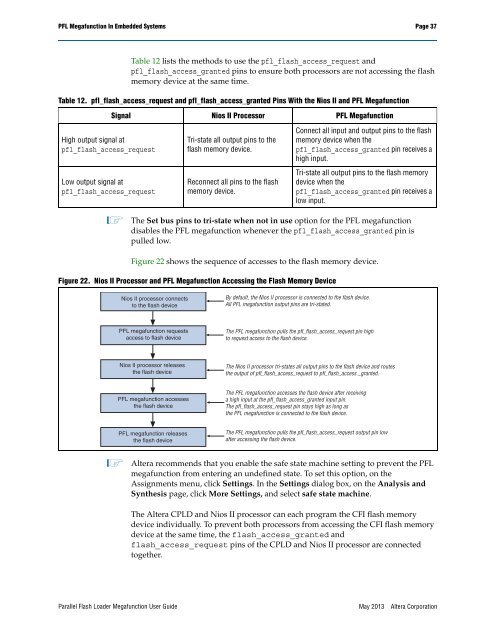Parallel Flash Loader Megafunction User Guide (PDF) - Altera
Parallel Flash Loader Megafunction User Guide (PDF) - Altera
Parallel Flash Loader Megafunction User Guide (PDF) - Altera
You also want an ePaper? Increase the reach of your titles
YUMPU automatically turns print PDFs into web optimized ePapers that Google loves.
PFL <strong>Megafunction</strong> In Embedded Systems Page 37<br />
Table 12 lists the methods to use the pfl_flash_access_request and<br />
pfl_flash_access_granted pins to ensure both processors are not accessing the flash<br />
memory device at the same time.<br />
Table 12. pfl_flash_access_request and pfl_flash_access_granted Pins With the Nios II and PFL <strong>Megafunction</strong><br />
Signal Nios II Processor PFL <strong>Megafunction</strong><br />
High output signal at<br />
pfl_flash_access_request<br />
Low output signal at<br />
pfl_flash_access_request<br />
Tri-state all output pins to the<br />
flash memory device.<br />
Reconnect all pins to the flash<br />
memory device.<br />
Connect all input and output pins to the flash<br />
memory device when the<br />
pfl_flash_access_granted pin receives a<br />
high input.<br />
Tri-state all output pins to the flash memory<br />
device when the<br />
pfl_flash_access_granted pin receives a<br />
low input.<br />
1 The Set bus pins to tri-state when not in use option for the PFL megafunction<br />
disables the PFL megafunction whenever the pfl_flash_access_granted pin is<br />
pulled low.<br />
Figure 22 shows the sequence of accesses to the flash memory device.<br />
Figure 22. Nios II Processor and PFL <strong>Megafunction</strong> Accessing the <strong>Flash</strong> Memory Device<br />
Nios II processor connects<br />
to the flash device<br />
By default, the Nios II processor is connected to the flash device.<br />
All PFL megafunction output pins are tri-stated.<br />
PFL megafunction requests<br />
access to flash device<br />
The PFL megafunction pulls the pfl_flash_access_request pin high<br />
to request access to the flash device.<br />
Nios II processor releases<br />
the flash device<br />
The Nios II processor tri-states all output pins to the flash device and routes<br />
the output of pfl_flash_access_request to pfl_flash_access _granted.<br />
PFL megafunction accesses<br />
the flash device<br />
The PFL megafunction accesses the flash device after receiving<br />
a high input at the pfl_flash_access_granted input pin.<br />
The pfl_flash_access_request pin stays high as long as<br />
the PFL megafunction is connected to the flash device.<br />
PFL megafunction releases<br />
the flash device<br />
The PFL megafunction pulls the pfl_flash_access_request output pin low<br />
after accessing the flash device.<br />
1 <strong>Altera</strong> recommends that you enable the safe state machine setting to prevent the PFL<br />
megafunction from entering an undefined state. To set this option, on the<br />
Assignments menu, click Settings. In the Settings dialog box, on the Analysis and<br />
Synthesis page, click More Settings, and select safe state machine.<br />
The <strong>Altera</strong> CPLD and Nios II processor can each program the CFI flash memory<br />
device individually. To prevent both processors from accessing the CFI flash memory<br />
device at the same time, the flash_access_granted and<br />
flash_access_request pins of the CPLD and Nios II processor are connected<br />
together.<br />
<strong>Parallel</strong> <strong>Flash</strong> <strong>Loader</strong> <strong>Megafunction</strong> <strong>User</strong> <strong>Guide</strong><br />
May 2013<br />
<strong>Altera</strong> Corporation
















